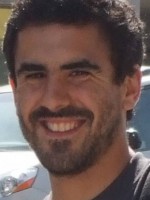resumo
The preparation, characterisation and structural analysis of a series of zirconium(IV) complexes that incorporate the diamido/diamine macrocyclic ligand Bn(2)Cyclam (Bn(2)Cyclam = 1,8-dibenzyl-1,4,8,11-tetraazacyclotetradecane) are described. The reaction of one or two equivalents of the appropriate LiNHR reagents with [(Bn(2)Cyclam)ZrCl(2)] give the corresponding amido-chloride [(Bn(2)Cyclam)ZrCl(NHR)] (R = (t)Bu, (2,6-iPr)Ph) or bis(amido) [(Bn(2)Cyclam) Zr(NHR)(2)] (R = (i)Pr, (t)Bu, (2,6-Me)Ph) complexes, respectively. Treatment of [(Bn(2)Cyclam)ZrCl(NH(2,6- iPr)Ph)] with one equiv. of MgClMe gives the base-free, monomeric imido complex [(Bn(2)Cyclam)Zr(N(2,6-iPr)Ph)]. The reaction of the tBu analog with MgClMe generates a dimeric bridging imido species [{(Bn(2)Cyclam)Zr}(2)(mu-NR)(2)], which can also be obtained by thermal decomposition of [(Bn(2)Cyclam)Zr(NHtBu)(2)] in toluene. The bis(hydrazido) complex [(Bn(2)Cyclam)Zr(NHNPh(2))(2)] was obtained by reaction of [(Bn(2)Cyclam)ZrCl(2)] and two equiv. of LiNHNPh(2). A hydrazido-chloride compound [(Bn(2)Cyclam)ZrCl(N(Ph)NBu(Ph))] was generated in a one-pot reaction between [(Bn(2)Cyclam)ZrCl(2)], LiBu and azobenzene. DFT calculations on [(Bn(2)Cyclam)ZrXY] complexes indicate that the coordination geometry adopted by these species is dictated by the steric bulk of the ligands X and Y, varying between six-coordinate prismatic and four-coordinate tetrahedral.
palavras-chave
MOLECULAR-ORBITAL METHODS; EFFECTIVE CORE POTENTIALS; GAUSSIAN-TYPE BASIS; INTRAMOLECULAR HYDROAMINATION; ASYMMETRIC HYDROAMINATION; CATALYTIC HYDROAMINATION; POLARIZATION FUNCTIONS; ORGANIC-MOLECULES; TRANSITION-METALS; BASIS-SETS
categoria
Chemistry
autores
Munha, RF; Veiros, LF; Duarte, MT; Fryzuk, MD; Martins, AM
nossos autores
Grupos
agradecimentos
We are grateful to Fundacao para a Ciencia e Tecnologia, Portugal, for funding in the form of research grants (POCI/QUI/55744/2004 and SFRH/BD/29986/2006). We would like to thank the Zurich Crystallography School 2007 for data collection of compound 2 and Mr Howard Jong for valuable discussions on the subject of crystallography and to the Portuguese NMR Network (IST-UTL Centre) for providing access to the NMR facility.


